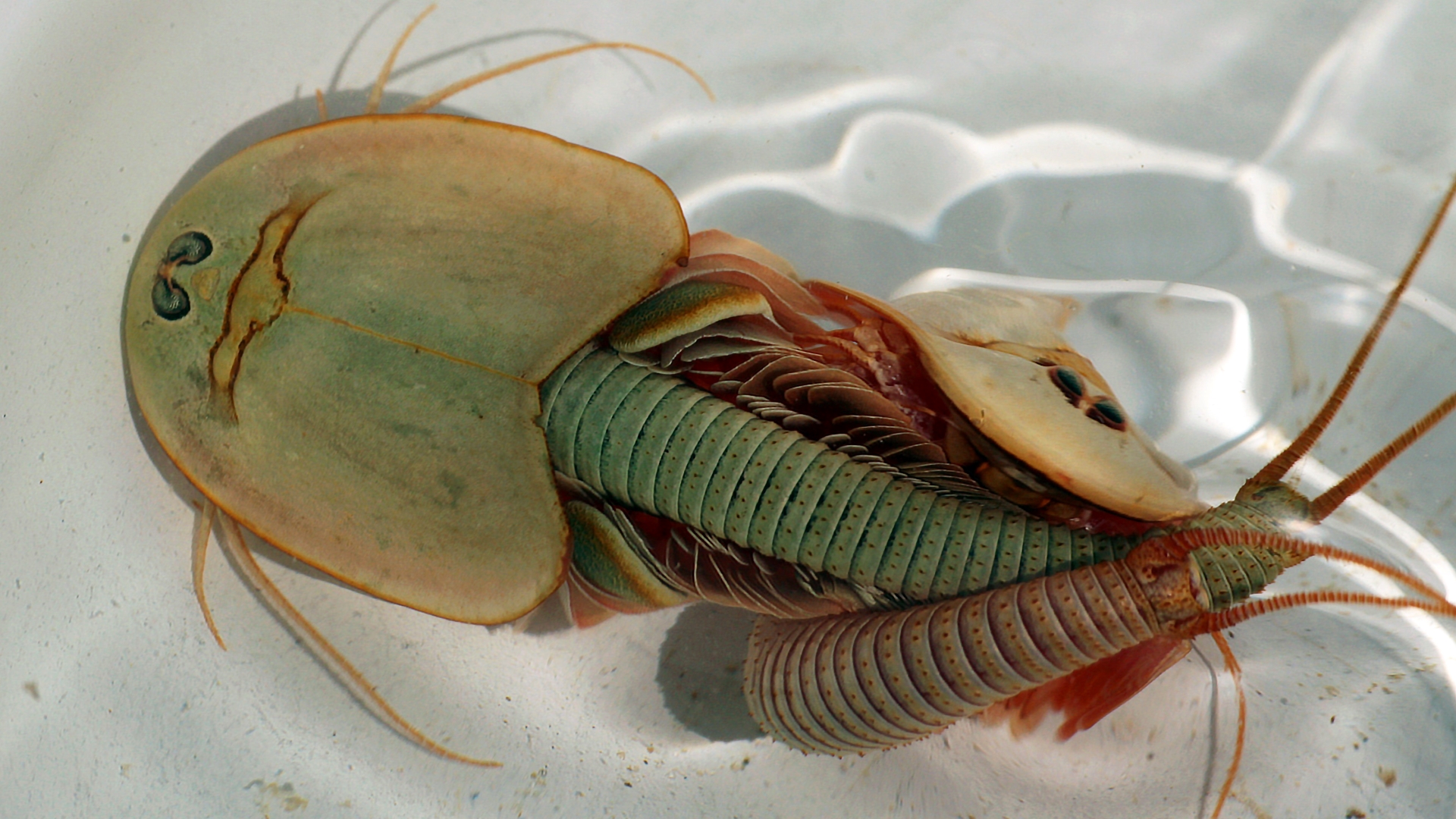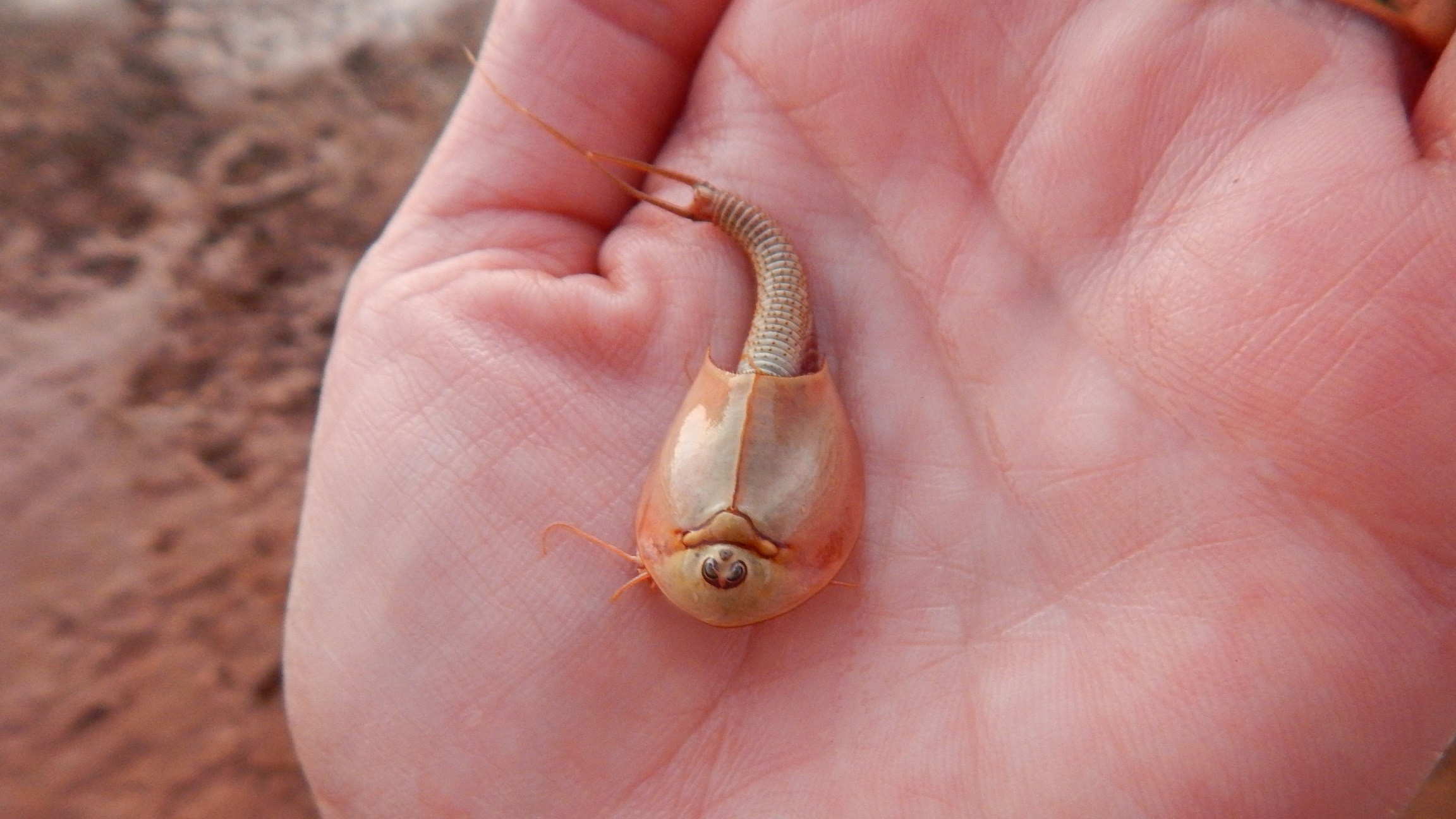Triops: Facts about the three-eyed 'dinosaur shrimp'
Triops belong to an ancient group of crustaceans.

Triops are a group of freshwater crustaceans commonly called tadpole shrimp or dinosaur shrimp. They look like ancient armored tadpoles, a look they've rocked for hundreds of millions of years. The word "Triops" means "three eyes" in Greek, and the group is so named because they have two main compound eyes and a third simple organ called an ocellus eye that helps them detect light.
The animals are not shrimp, which is a name usually reserved for marine crustaceans in the order Decapoda (Triops are in the order Notostraca). But like shrimp, Triops — one of two genera in its own family and order — live in water. In fact, Triops have adapted to an extreme life in temporary freshwater or slightly salty pools that may only last a few weeks before drying out.
Are Triops dinosaurs?
Triops' appearance hasn't changed much since the group first emerged in the Devonian period (419 million to 359 million years ago), according to Central Michigan University in Mount Pleasant, Michigan. This ancient and morphologically consistent lineage led some people to call the creatures "living fossils," a term that's also commonly used to describe deep-sea fish called coelacanths (SEE'-lah-kanths) and horseshoe crabs — another animal that looks a bit like Triops.
Scientists used to consider one Triops species, Triops cancriformis, as being the same animal seen in 250 million-year-old fossils. That would mean Triops cancriformis had survived to the present day from the Triassic period (about 252 million to 201 million years ago) when dinosaurs first emerged — hence the name "dinosaur shrimp." However, a 2013 study of Triops DNA published in the journal PeerJ found that the current species evolved within the last 25 million years.
"Living fossils evolve like any other organism, they just happen to have a good body plan that has survived the test of time," study lead author Africa Gómez, an evolutionary biologist at the University of Hull in England, said in a statement at the time. "A good analogy could be made with cars. For example, the Mini has an old design that is still selling, but newly made Minis have electronic windows, GPS and airbags: in that sense, they are still 'evolving', they are not unchanged but most of the change has been 'under the hood' rather than external."
Related: This 'ancient' monster fish may live for 100 years
Where do Triops live?
The Triops group is found on every continent except for Antarctica. The Integrated Taxonomic Information System (ITIS) recognizes 13 different species in the Triops genus, including the Australian tadpole shrimp (Triops australiensis) in Australia, Triops emeritensis in Europe and northern Asia, and Triops maximus in Africa. The U.S. has two native species: Newberry tadpole shrimp (Triops newberryi) and summer tadpole shrimp (Triops longicaudatus).
Get the world’s most fascinating discoveries delivered straight to your inbox.
Summer tadpole shrimp have the widest distribution of all the Triops species and are found throughout the U.S. (except for Alaska), Canada, the Caribbean, Japan and some Pacific Islands, though humans likely introduced them to Japan and the Pacific Islands, according to the University of Michigan's BioKids website.
How big do Triops get?
Triops usually grow to be no more than a few inches in length. For example, summer tadpole shrimps reach about 1.6 inches (4 centimeters) long, and this is still considered quite large for Triops, according to BioKids. Australian tadpole shrimp are larger and max out at about 3.5 inches (9 cm) long, according to the Western Australian Museum.
How do Triops breed?
Because Triops' water habitats are only temporary, they mature quickly and go from eggs to breeding adults in two to three weeks, according to Buglife, an invertebrate conservation charity in the U.K. Triops are hermaphrodites, which means each individual has both sexual organs, but they can also reproduce sexually and even produce offspring from unfertilized eggs. This flexibility when it comes to reproducing helps each generation of Triops give rise to another in extreme environments, including deserts.
Triops' eggs may enter "diapause," which is a state of dormancy in which the eggs stop developing and dry out. Diapause allows the eggs, and the Triops inside, to survive when their watery pools evaporate in arid conditions. The eggs may stay in diapause for up to 27 years, waiting for water to return so they can hatch, according to Buglife.
Related: 100 million-year-old fairy shrimp reproduced without sex, rare fossils reveal
When conditions are favorable, these animals can suddenly hatch in large numbers. For example, hundreds of Triops emerged in an ordinarily dry ceremonial ball court — a circular walled structure — at Wupatki National Monument in northern Arizona in 2021, Live Science previously reported.
"We knew that there was water in the ball court, but we weren't expecting anything living in it," Lauren Carter, lead interpretation ranger at Wupatki National Monument, told Live Science at the time. "Then a visitor came up and said, 'Hey, you have tadpoles down in your ballcourt.'"
The "tadpoles" were Triops that hatched after a monsoon created a temporary lake in the ball court. After they've hatched, Triops live up to 70 days in the wild and 90 days in captivity, according to BioKids.
What do Triops eat
Triops are very adaptable and have a varied diet that includes scavenging floating organic material in their pools and hunting things like zooplankton and insect larvae. When food is scarce, they may even eat each other. Summer tadpole shrimps are a pest in rice fields because they eat young crops and make crop water muddier so less light reaches the plants, according to Central Michigan University.
Birds, especially waterfowl, eat Triops. The threat of predation is so great for Triops that they tend to be solitary, because potential predators are more likely to see and eat a group of them, according to BioKids.
Are Triops endangered?
Four species of Triops face extinction, according to the International Union for Conservation of Nature (IUCN): Triops gadensis, Triops baeticus and Triops vicentinus are endangered and Triops emeritensis is critically endangered. All four species live on the Iberian Peninsula in Spain and Portugal, and are threatened by human activities such as development and agriculture.
The IUCN hasn't assessed either of the species found in the U.S. However, Newberry tadpole shrimps are classified as "secure" — not at risk of extinction — according to NatureServe, a non-profit based in Virginia that collects data on North American wildlife.
Additional resources
To view a map of where Triops is found across the world, check out the Encyclopedia of Life website. To learn more about how Triops longicaudatus survive in the U.S., watch this short YouTube video by Zion National Park. For more information about Triops, check out "Timeless Triops: A Prehistoric Creature" (Lori Adams Photo, 2014).
Originally published on Live Science.

Patrick Pester is the trending news writer at Live Science. His work has appeared on other science websites, such as BBC Science Focus and Scientific American. Patrick retrained as a journalist after spending his early career working in zoos and wildlife conservation. He was awarded the Master's Excellence Scholarship to study at Cardiff University where he completed a master's degree in international journalism. He also has a second master's degree in biodiversity, evolution and conservation in action from Middlesex University London. When he isn't writing news, Patrick investigates the sale of human remains.



